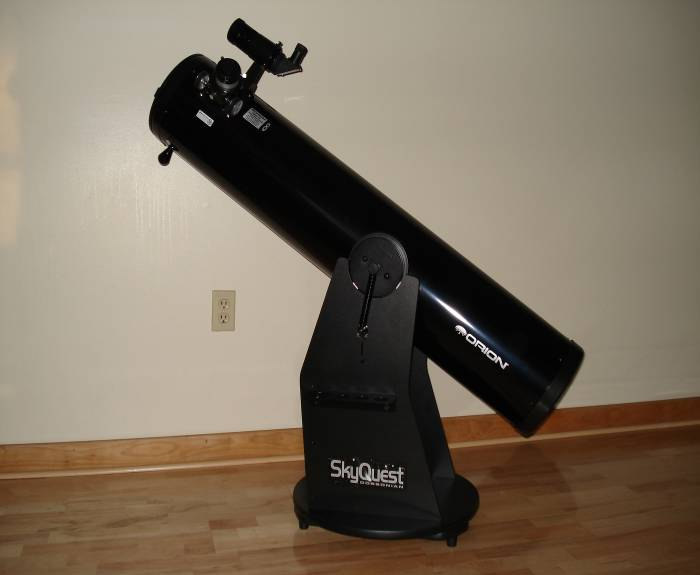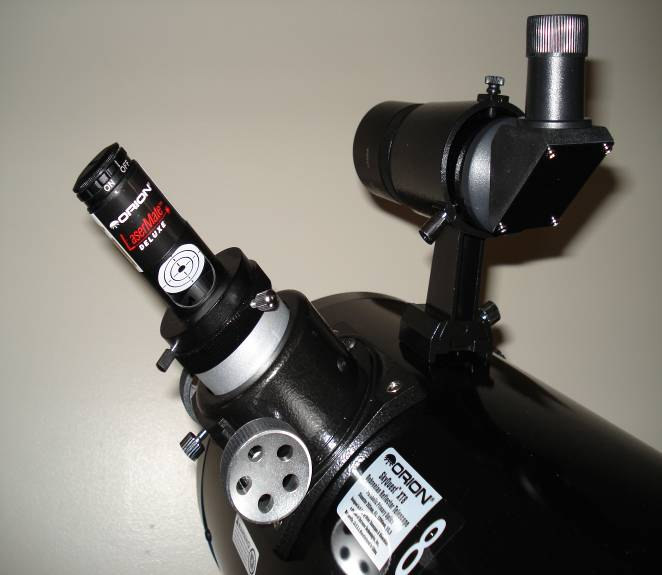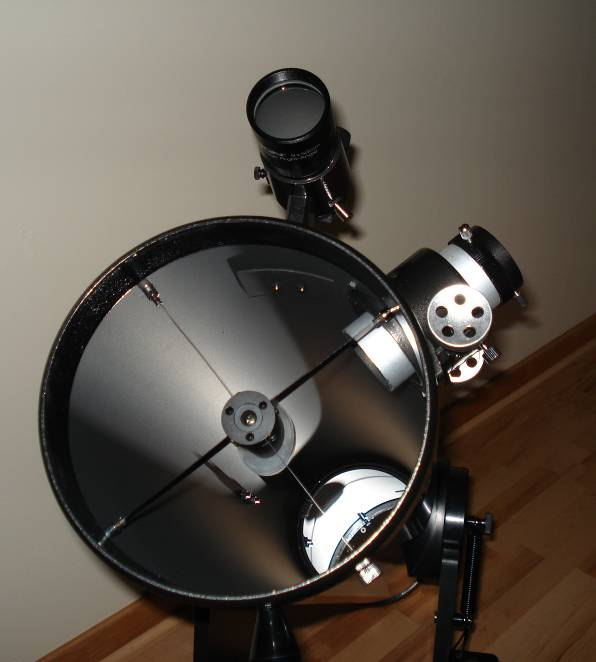

I have owned only two scopes in probably over a dozen years of observing, a 13-inch Coulter (that I liquidated to purchase...) and an 18-inch Obsession. To me, size matters. Having said that I have come to the concussion that I needed a grab-and-go scope that can be used for backyard observing and perhaps to join in some ACNO observing. (Don’t worry, the 18 is alive and well, and still gets my full attention). I was considering obtaining one of the many new 80 mm refractors that are on the market, but as Doug Scobel indicated—“its still only 80 mm of aperture.” That comment made me think of what I really wanted. A grab-and-go scope had to be....

I recalled years ago using the club’s Cave 8-inch f/6 scope, and thought that a similar scope would make a great grab-and-go scope. I started reading on the web and looking in old Sky & Telescope magazines when I happened upon the Orion SkyQuest line of scopes. Making a long story shorter, I could not help noticing the SkyQuest XT 8 Classic appeared to have what I was looking for. This scope is an 8-inch, f/5.9; and, at $370 bucks plus shipping, was very affordable. Unpacking—Got home Friday afternoon to find some FedEx footprints coming up the driveway. Two Orion boxes, one large and one small, arrived. Yippee! Commenced to open the big box expecting to find the accessories in it. Located the Sirius Plossls 25 MM and 10 MM eyepieces. Evidence of multi-coated surfaces are showing green. Next found the LaserMate Deluxe collimator. This unit is designed to allow observing the beam return while adjusting the primary at the rear of the scope. I turn it on and notice a big fat beam. Concerns abound as I wonder if this collimator will be accurate. I locate the 9x50 correct image right-angle finder scope (a recent upgrade from the 6x30 finder).

Those that know me know I like this type of finder (see my previous article on an Antares 8x50 correct-image right-angle finder scope at: http://www.umich.edu/~lowbrows/reflections/2002/csarnecki.12.html). I have seen the Orion 9x50 right-angle finder scope on the ‘Hill’ previously and found it to be a very nice little finder scope. Nestled in the bottom to the tube box are Orion’s DeepMap 600, a couple Starry Night CDs, and printed instructions.
Now it was time to open the small box and assemble rocker box so I would have something to set the tube on when I pulled it from the tube box. It is worth mentioning that the plastic laminated particle board rocker box panels are very well packaged and protected. The rocker box goes together in about 15 minutes. One gets the impression that everything including the rocker box is well thought out. Fasteners are high quality oversized non-corrosive hardware designed to connect in to particle board construction and transfer loads. The plastic bearings are lightweight square pieces stapled to the ground board and altitude bearings points. A Sky & Telescope article recommends sanding these to allow them to ride smoother. Another common recommendation is to add plastic milk bottle washers to the azimuth bolt to transfer some of the weight from the ground board bearings to the washers. After aggressively polishing off a gallon bottle of milk, I cut out four plastic washers and add them to the ground board bolt. The resulting azimuth movement can only be described as ‘buttery.’ If you own a dob, you really should do this as the azimuth movement is improve immeasurably.

With the rocker box assembled, it is time to liberate the optical tube assembly (OTA) from the packing box. I should say, boxes, because Orion places the tube in a double cardboard box supported at each end and mid-point by oversized styrofoam blocks. The black metal OTA is very well though out, with substantial castings supporting the primary and a snap on cover that looks like it is bullet resistant. The 2-inch Crayford focuser is a monster with brushed aluminum focus wheels with rubber inserts. The mirror cell has nice knurled knobs well placed for adjusting the mirror, and is prepared for a cooling fan attachment (future upgrade). Will the Lowbrow with the 9-volt battery powered muffin fan please step foreword? The spider is a nice narrow 4-vaned style unit, upgraded from a 3-vaned unit.
It was now time to collimate the optics. Wondering how the Orion laser collimator would work, I slapped the unit in to the focuser and turned it on. In the optic path, the red laser produced a narrow beam, although not as nice as a Howie Glatter unit, but hey; this was a far more economical acquisition. The collimator has a feature to allow one to adjust the primary cell at the rear of the OTA while observing the return beam in an angled 45 degree white reflector in the collimator itself. But first one has to use a tiny Allen wrench to adjust the secondary.
Intermission
Atwater Block Brewery, Detroit MI, Vanilla Java Porter—Bursting with a full vanilla and java flavored belt, this Detroit porter could be a replacement for your AM joe.
Victory Brewing Co., Downingtown, PA, Storm King Stout—Pours black as night at BFSP. At 9% ABV, a couple of these could dark eye adapt you pretty quick.
Nine G Brewing Co., South Bend, IN, Blacksnake Porter—Delivers an upper cut to your palate with a nice little bitter ending.
First Light—As luck would have it, and I do mean luck in mid-January Michigan weather, it was clear! Having set the newly assembled scope in the garage to cool down for a half hour, it was time for some first light. Yippee again! The Moon was just past first quarter, so I plopped the 25 mm Plossl in to the eyepiece and located the object. Sweeeet. The 25 mm gave about a degree worth of field, and as they say, the Moon never disappoints. I reminded of the saying “A small tree in one’s backyard is larger than the biggest redwood in the forest.” This little scope was a real performer. Using the Moon as a found object, I centered the finder scope and attempted to focus it. No luck in figuring the focus on the finder. Guess I’ll just use some dead reckoning to locate the next object, the Orion nebula. After all this is Orion’s scope. The nebula’s green glow forms the ‘fish mouth’ and fills the one degree field of view. At almost 50 power, the eyepiece shows the trapezium stars nicely. Time to swap out eyepieces and try the 10 mm (120X). Mm, stars are not so pin pointy. Run in the house to grab the 7 mm Nagler for some comparison viewing. You might wonder about using an eyepiece in a scope that cost almost as much as the scope. However the Nagler stars are also not very sharp. Reminded that I should star test the optics, I move over to Polaris. In simple terms, star testing the optics involve de-focusing a moderately bright star on both sides of focus equally to set how the two images compare. Attempting to de-focus Polaris, I realize why stars are sloppy. The scope hasn’t yet cooled down properly. Not to be deterred, I proceed to Sirius. In the dark, I manage to figure out how to focus the finder scope. Grabbing the Sky & Telescope Pocket Star Atlas (highly recommended) I am on to M47 and M46. Using the 25MM eyepiece, M47 pops in to view. Nice pin point stars. With the correct-image right-angle finder scope, I navigate to M46. Somehow it is not as easy as I thought. The transparency isn’t very cooperative, what with a plus first quarter Moon and winter transparency. Next up is M35. Together with the Pocket Star Atlas and the correct-image right-angle finder scope, I can’t lose. M35 stars flood the field of the 25 mm eyepiece. Notice some smallish clouds booking it through my local sky. Since I am at M35, I’ll try NGC 2158, an 8 1/2 mag open cluster shadowing M35 at over 5 times the distance of M35 from our vantage in space. Can’t locate, so I back up to M35. All of a sudden I can’t find any star. It seems that a cloud front moved in, and first light was canceled by Mother Nature. Such is winter observing in Michigan. Oh, well. It was good while it lasted. I did come away with an appreciation that the optics are fine. Will leave a more detailed evaluation for the next time out. Summing up—A label on the side of the Orion SkyQuest XT 8 Classic indicates it is designed in the USA and manufactured in China. It is a well designed scope at an unbelievable value for your money. I read in scope reviews that scope prices don’t go down over time, but your do get more for your money. This scope was initially listed at $499 bucks in 2000, and with less accessories. In early 07 this same size scope with several added accessories is listed for less. Orion has continued to upgrade the scope with a larger 9x50 correct-image right-angle finder scope from the previous 6x30 straight-thru finder, a 2-inch Crayford focuser replaces the older rack-and-pinion focuser; and, adding a laser collimator to round out the offering.
As a permanent sufferer of aperture fever, I am glad I got the 8-inch. For $180 bucks more one can get the 10-inch ($500 more for the 12), but this scope weighs in at 55 pounds (81 pounds for the 12-inch) instead of the 41 pounds of the 8-inch. Doesn’t sound like a lot, but lifting the 8-inch, I realize I am not as young as I think. The 8-inch is the limit of my lifting. Am I happy with my selection? You bet. Any new scope should open up or re-open up the Universe all over again. I can’t wait to get out there.